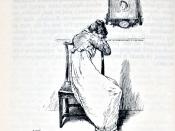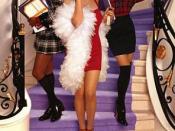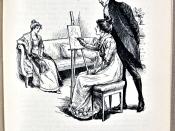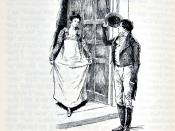Transformation comes in many different forms. In the transformation from Emma to Clueless the viewer experiences a number of changes. Things such as the change of medium, culture, setting and target audiences are all common when transforming a text and the transformation between Emma and Clueless is no exception.
The most noticeable change between texts is the change from a novel to a film. This form of change has many implications for the viewer. In Emma, Austen provides the reader with very lengthy descriptions. What may take Austen pages to describe is presented by Heckerling in Clueless in a mere shot. This is very evident in the texts. In Clueless Cher (Alica Silverstone) simply has to do a voice over with the words "Isn't my house classic?"ÃÂ whilst the viewer looks at her placial mansion to give the viewer an exact image of the house in which Cher lives. In Emma Austen devotes pages to the description of her abode not only giving us a straight description before we encounter dialogue but also by adding in various remarks through the characters dialogue and narrative comments.
The change between novel and film gives us another way of looking at things. Where as in a novel we are only guided by the author, in a movie our opinions can be formulated through a variety of different methods. Things such as colour, tone of voice, expressions and actions can only be described by the author where as in a film we can see and therefore interpret these things ourself. Another thing is the use of sound. Often in films the viewer is encounters music and sound which help represent the mood. In Austens Emma the party thrown by Frank Churchill can only be described, forcing the reader to rely upon the literary skills of Austen. However in Clueless the viewer is present with a barrage of information through lighting, music, sound effects and actions.
Another aspect of the change between Emma and Clueless is the change in culture. Austen wrote Emma in the late 1700's. As such Emma was written for a "ÃÂproper' society which was ruled by tradition. Women were subservient to men, many people called their peers Mr or Mrs, promiscuity was exceedingly low, and the expectations upon people were very strict. Contrasting this with Clueless the viewer sees a society of fast cars, girls wearing "ÃÂrevealing' attire, the presentation of homosexuality and a change in social interaction. The biggest change in culture is the change in the views of sex and marriage. In Clueless the viewer is presented with a much more liberal society. Cher almost throws herself at Christian in a vain effort for him to like her, contemplating sex with someone who she doesn't even know about. Also the viewer is told that after the incident on the LA freeway, Dione virginity goes from "ÃÂtechnical to non-existent'. However in Emma, Emma says "Impossible! "ÃÂ I never can all you anything but "ÃÂMr Knightley'"ÃÂ, to the gentleman she is becoming engaged to. We are never presented with anyone kissing or holding hands let alone their sexual conquests. Quite obviously, some of the values held by society have changed. However the entire set of values held by the people of Highbury can not be said to be non-existent in Beverly Hills. Wealth is still high on the agenda. The way in which wealth is expressed in Highbury is not dissimilar to the expression of wealth in modern day Beverly Hills. The huge houses, the personal transportation (either a car or dog kart) and the need for appropriate fashion have not changed at all.
This change in culture can be attributed to both the change in time period and the change in setting. The viewer is transported from 1790's country England to the 1990's "ÃÂhussle and bussle' of modern day Los Angles, America. The pace in Emma is very much laid back. Austen's ability to transfer the quiet, slow pace of county England is marvellous. Her ability to structure a sentence so as to slow the reader down is extraordinary and in doing so the reader becomes one with the society and has a better feeling for the events which unfold. (Not part of the essay: the last 2 sentences equate to the term "It was boring as all buggery"ÃÂ). Emma is written in a period where the members of society are extremely well mannered and polite to one another. Contrasting this to America in the 1990's presents two totally different images. America with its confronting approach to life, the frantic pace and the promiscuous nature of society present a direct contrast to the slower lifestyle of the people of Highbury. However the two places are not totally different. One thing that remains common between Emma and Clueless is the need for a heirachy. This is clearly shown when Emma goes to do her charity work and visit "ÃÂthe poor'. It is also evident when Emma tells Harriet that Mr Martin is below her social standing and that Harriet deserves someone of a better standing in society. There is almost a direct transferral of this idea into Clueless when Cher is telling Tai about the different group. Cher says, "If you make the decision to date a high school boy, they are the only acceptable ones."ÃÂ (Made in reference to the group containing Elton and Murray).
The last major change in the transformation between Emma and Clueless is the change in the age of the characters and the target audience. In Emma the viewer is presented with characters who are from anywhere between the early 20's up to there 80's or 90's. The main protagonist is in her mid twenties. Also Emma was written for women in the 1700's. The language use and themes are aimed at her target audience. Clueless on the other had is filled mostly with people in there later teens with the main protagonist being approximately 16. Heckerling's target audience is teenagers in modern day America and developed countries. As such the ways in which Clueless presents the images, themes and ideas from Emma are very different. The language used, the symbols, activities, and the surroundings all have to be changed. This is very evident as many of todays teenagers have trouble identify with the characters and often have trouble coping with the vocabulary and literary style presented by Austen. Along with this is the fact that many of the problems are discussed at an adult level. This level of maturity often makes it hard for teenage readers. Heckerling has taken the themes and ideas and adapted them and put them in such away that teenagers can understand them. This such as the party in the Valley and when Cher is in the car with Elton and he tries to kiss her. These events have been recontextualised. If Elton had just professed his love for Cher teenage audiences would have had trouble connecting between their lives and the lives being portrayed on the screen.
Whilst many things have changed in the transformation from Emma to Clueless the basic themes, ideas and images have remained unaltered. Emma has merely been changed superficially changed so that the presentation of these themes, ideas and images can be easily identified by the target audience in the 1990's in the form of Heckerlings Clueless.





